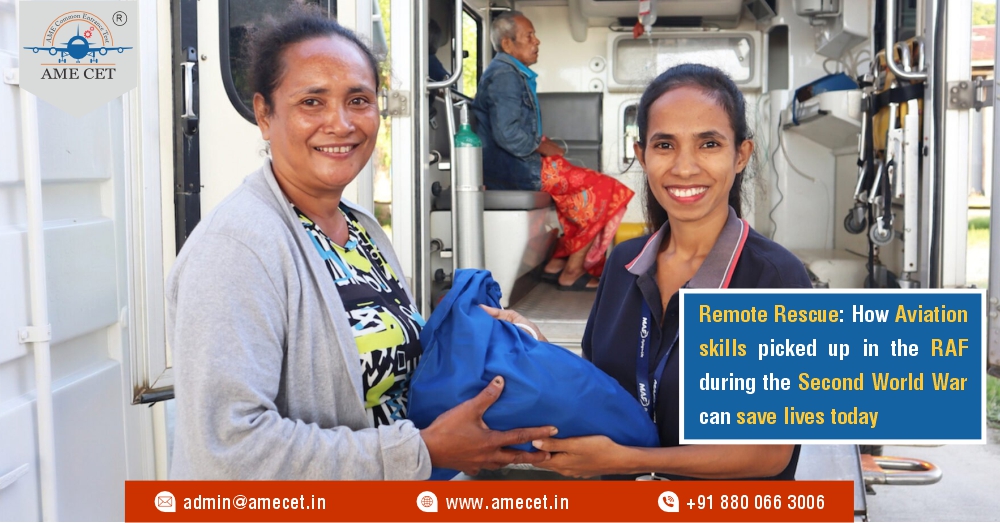
In the realm of emergency response, history often provides us with invaluable lessons that can shape the future. One remarkable example lies in the aviation skills developed by the Royal Air Force (RAF) during World War II, particularly in remote rescue operations. As we face new challenges in saving lives today, the techniques, strategies, and experiences gained during the war offer crucial insights that are still applicable in modern contexts.
The RAF's Legacy in Rescue Operations
During World War II, the RAF was tasked with a myriad of operations, including bombing missions, reconnaissance, and vital supply drops. One of the most challenging aspects of these operations was the rescue of downed pilots and crew members in hostile territories. The RAF developed specialized skills and techniques for locating, approaching, and extracting personnel from remote and often dangerous environments. This experience laid the foundation for many of the rescue strategies employed today.
Pilots and crews learned to work with limited resources, often in extreme weather conditions, using improvisation and quick thinking to save lives. Techniques such as aerial searches, coordinated ground support, and the use of helicopters for extraction became essential. These skills were not only vital during the war but have since evolved into more sophisticated rescue operations.
Modern Applications of WWII Skills
Today, these historical skills have found new life in various fields, from mountain rescue teams to search and rescue (SAR) missions conducted by coastguards and emergency services. The principles of aerial reconnaissance and the ability to navigate challenging terrains are as relevant now as they were then.
-
Search and Rescue Operations: Modern SAR teams frequently employ aerial support, using helicopters to locate and extract individuals stranded in remote locations. Techniques developed in the RAF, such as aerial reconnaissance and coordinated rescue efforts, are standard practices. These teams utilize advanced technology, including drones and thermal imaging, but the fundamental principles remain rooted in the lessons learned during WWII.
-
Disaster Response: In the face of natural disasters, such as earthquakes or floods, the ability to conduct aerial assessments and deliver aid is critical. RAF experience in logistics and supply drops during wartime is mirrored in current disaster response efforts. The ability to quickly assess damage from the air and deploy resources effectively is crucial in saving lives.
-
Mountain and Wilderness Rescue: The skills honed during WWII are particularly relevant in mountain and wilderness rescue scenarios. Teams trained in techniques that originated in the RAF are often the first responders in these challenging environments. The knowledge of navigation, survival, and extraction methods is vital for successful missions.
Training the Next Generation
To ensure that the skills and techniques developed during WWII continue to be relevant, training programs have been established that emphasize historical knowledge alongside modern technology. Organizations involved in rescue operations frequently incorporate lessons from RAF experiences into their training curricula.
-
Simulated Training Exercises: Rescue teams often engage in simulated exercises that mimic historical rescue scenarios. These drills not only teach modern techniques but also instill the principles of teamwork, communication, and adaptability that were essential during wartime operations.
-
Cross-Disciplinary Training: Collaboration between military veterans and civilian rescue organizations fosters a transfer of knowledge. Veterans from the RAF bring firsthand experience and insights into effective rescue operations, enriching training programs for current responders.
-
Emphasizing Historical Context: Understanding the historical context of rescue operations enhances situational awareness for modern rescuers. Training that incorporates the challenges faced by WWII pilots and crews prepares today’s responders to think critically and act decisively in high-pressure situations.
The Impact of Technology
While the foundational skills of remote rescue have their roots in WWII, technological advancements have significantly transformed how these operations are conducted. The integration of drones, advanced communication systems, and GPS technology has enhanced the efficiency and effectiveness of rescue missions.
-
Drones: Unmanned aerial vehicles (UAVs) are now being deployed in search and rescue operations. They can cover large areas quickly, providing real-time data and imagery that aid in locating missing persons. This technology complements the traditional skills developed in the RAF, allowing for a more comprehensive approach to rescue.
-
Advanced Communication Tools: Modern communication systems enable better coordination among rescue teams. The ability to share information instantaneously across various platforms improves situational awareness and decision-making during missions.
-
Data Analysis and Predictive Modeling: The use of data analysis and predictive modeling enhances planning and response efforts. By analyzing patterns and historical data, rescue teams can anticipate challenges and allocate resources more effectively.
Conclusion: A Testament to Human Ingenuity
The skills developed by the RAF during World War II serve as a testament to human ingenuity and resilience. The ability to adapt and innovate in the face of adversity has led to the establishment of effective remote rescue techniques that continue to save lives today.
As we honor the legacy of those who served in the RAF, we must also recognize the importance of integrating historical knowledge into contemporary practices. By combining the foundational skills from the past with modern technology and training, we can enhance our capacity to respond to emergencies and save lives in the present and future.
In a world that often seems increasingly complex, the lessons learned from history remind us that the past can guide our efforts to protect and serve humanity, ensuring that the spirit of innovation and courage endures for generations to come
Category
-
Aircraft Maintenance Engineering (DGCA) (55)
-
Cabin Crew (1)
-
Aircraft Maintenance Engineer (AME) (1)
-
Aerospace Engineering (3)
-
Commercial Pilot License(CPL) (81)
-
(188)
-
Aircraft Maintenance Engineering (BTech/BE) (4)
-
Aeronautical Engineering (2)
-
Airport Management (5)
-
Aircraft Maintenance Engineering (EASA) (11)
-
Airport Ground Staff (1)
-
B.Sc. in Aviation (1)
-
AME CET (5)
